2009 Pokémon Card Design Contest
(Part 1)
I've recently acquired a complete set of these cards, marking a major milestone in my collection. Information surrounding the release of this set is inconsistent and vague at best; this blog post is an attempt to collate 11 years of knowledge into a single point of reference.
Table of Contents

Introduction
On 27th February 2009 an article appeared on the official Japanese Pokémon TCG news feed with some information about an upcoming competition.[1] Between 28th February and 24th April 2009, Shogakukan, a major Japanese publishing house, would be hosting a card design contest across 12 of its children’s magazine publications to coincide with the upcoming release of the 12th Pokémon movie: Pokémon: Arceus and the Jewel of Life.
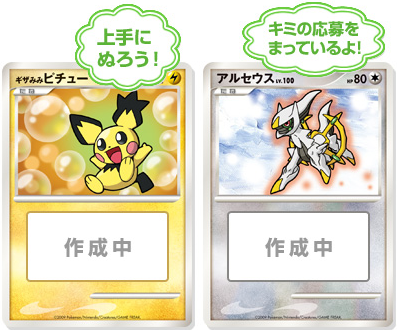
The contest centred around Spiky-eared Pichu and Arceus. This was the first time since May 1998 a contest in Japan had asked members of the public to design their own Pokémon card artwork that would end up printed as physical cards.

Each magazine included one of 2 different Pichu and 3 different Arceus templates to be coloured in.
Documented Schedule and Prizes
According to the Japanese Pokémon website, each magazine gave roughly 1 month for participants to post their designs over to an address published in each magazine. Participants had to include their name, grade, gender and age along with their address and phone number as part of a screening process to ensure only the target demographic were considered.
Schedule
- February 28th: Kindergarten (幼稚園), Televi-Kun (てれびくん) and Elementary School First Grade (小学一年生);
- March 3rd: Elementary School Second (小学二年生), Third (小学三年生), Fourth (小学四年生), Fifth (小学五年生) and Sixth Grade (小学六年生);
- March 14th: CoroCoro Comic (コロコロコミック) and Pucchigumi (ぷっちぐみ);
- March 18th: Pokémon Fan (ポケモンファン);
- March 25th: CoroCoro Ichiban! (コロコロイチバン!).
Prizes
- Highest award (1 person per magazine, 12 people total): 100 copies of a Pokémon card featuring their winning design and a Giratina Edition Nintendo DS Lite;
- Outstanding performance award (5 people per magazine, 60 people total): 1 copy of a Jumbo Pokémon card featuring their design and a DX Monster Ball DP;
- Special award (10 people per magazine, 120 people in total): Pikachu’s Ice Adventure DVD;
- Lucky award (30 people per magazine, 360 people in total): Garchomp vs Charizard SP Deck Kit.
The Winning Designs
In total 6 Spiky-eared Pichu and 7 Arceus designs were selected.
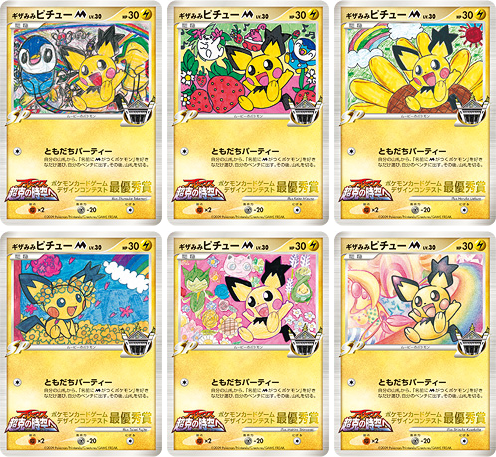
Each of the 13 cards have a gold stamp which reads Pokémon Card Game Design Contest: Highest Award (ポケモンカードゲームデザインコンテスト 最優秀賞).
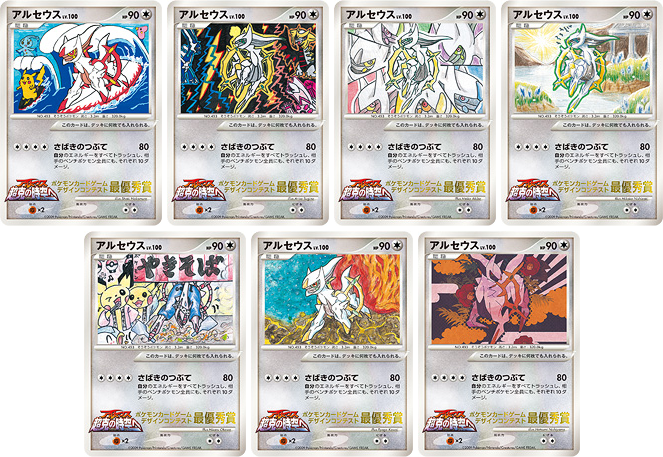
A lot of other Pokémon feature in the artwork of these cards: Budew, Butterfree, Celebi, Cresselia, Cyndaquil, Dialga, Diglett, Drifloon, Electrode, Giratina, Happiny, Jigglypuff, Luvdisk, Magnemite, Manaphy, Mew, Paklia, Pikachu, Piplup, Roselia and Shayminm – and I’m sure I’ve missed a few. On top of all of those, a very small Arceus makes an appearance in the Kindergarten winning Spiky-eared Pichu design, and Pichu makes an appearance in the CoroCoro Comic winning Arceus design (winking whilst wearing a pink shirt and using chopsticks to eat noodles – a minor detail not to be ignored).
Modern Day Confusion
If the figures published by the Japanese Pokémon website are to be believed, each highest award winner spread across the 12 magazines should have received 100 copies of their winning design and each outstanding performance award runner-up should have received 1 jumbo card with their design printed on.
It has now been 11 years since the contest was held and information is getting harder to come by, but there are several discrepancies with what was originally published.
Shōnen Sunday
The immediate problem with the officially-published information is that a thirteenth previously unmentioned magazine, Shōnen Sunday, also hosted the 2009 design contest. This meant that there were actually 13 winning designs printed instead of 12.
Comparison with Other Contests
A year after the 2009 contest a similar contest was run to coincide with the release of the thirteenth Pokémon movie, Pokémon: Zoroark – Master of Illusions. This time spread across 10 Shogakukan publications, the winners of the 2010 Pokémon Design Contest were once again set to receive 100 copies of their winning artwork.[2] This time no jumbo cards were announced for the runners-up.
Despite the 2009 contest having a year’s head start on the 2010 contest, significantly more of the 2010 cards have surfaced in the decade until now. At the time of writing this article, Professional Sports Authenticator (PSA) has graded 417 of the 10 winning 2010 designs[3], averaging at 41.7 of each card. Compare that to only 51 of the 13 winning 2009 designs[4], averaging at 3.9 of each card. 10.7 times more of each of the winning 2010 designs have been graded than the 2009 designs.
[2021 Update]: In July 2021 it was discovered that winners of the 2010 Design Contest actually received 200 cards, not 100 as published. The winner of the 2010 Pucchigumi contest shared an image of the pack of cards they received, showing quantity (数量) as 200.[11][12]
6 years after the 2009 contest, another contest which had similar distribution figures was the worldwide 2015 Pokémon Art Academy. PSA has graded 81 of the 10 winning Japanese designs[5], averaging at 8.1 of each card – 2 times more than the 2009 contest. Outside of Japan, PSA has graded 235 of the 12 winning North American, European and Oceanian designs[6], averaging at 19.58 of each card – 5 times more than the 2009 contest.
Jumbo Cards
Despite being listed as a prize for the runner-ups, none of the 60 outstanding performance award jumbo cards are known to have surfaced.
Instead of having jumbo cards listed as a reward for the runner-ups of the 2010 contest, those designs were instead showcased publicly on the Japanese Pokémon Movie website. Information pre-dating 2016 is sadly no longer accessible on that website, but it could have been the case that instead of being released as jumbo cards the 2009 runner-up designs may also have featured at one point on the web instead.
Cards which have Surfaced
Winners of the 2015 Pokémon Art Academy contest have spoken publicly to confirm that they were, as intended, awarded 100 of each of their winning designs as trading cards. With each card being distributed in this way, each winner ultimately has a monopoly over those cards to begin with and can chose exactly if and when they introduce their card onto the market. As such, 4 of the 22 Art Academy cards have yet to make an appearance at all, whilst some have as many as 51 copies graded by PSA.
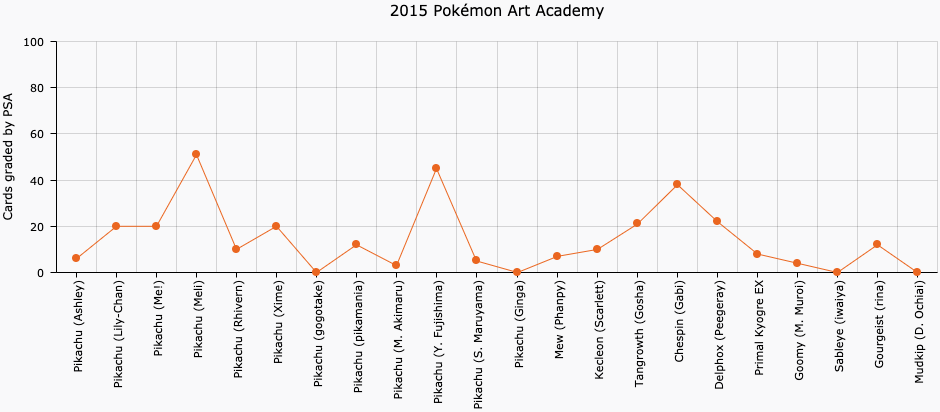
With both the 2009 and 2010 contests, however, when the cards did surface they almost always appeared as full sets. Unlike the Art Academy cards, there is an almost uniform distribution between the cards which have surfaced from these sets, shedding doubt on the 100 cards per winner claim. With the 2010 contest, the card with the fewest copies graded by PSA is the Pucchigumi Illusion’s Zorua at 37, and the card with the most graded copies is the CoroCoro Illusion’s Zoroark at 48.
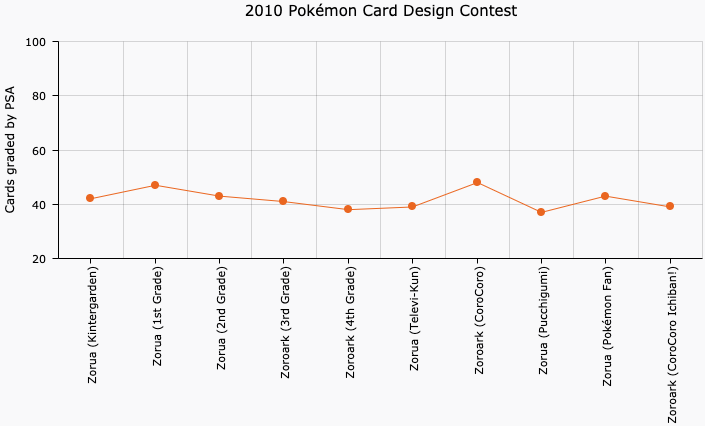
For the 2009 contest, four of the cards have been graded by PSA the fewest amount of 3 times and three of the cards have been graded by PSA the most amount of 5 times.
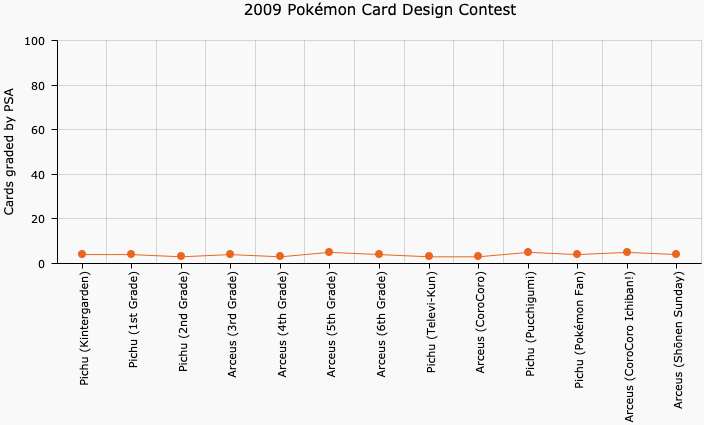
The above chart factors in 2 mislabelled cards which are yet to be corrected: 26074095 and 26074096.
Unofficial Statements
Bulbapedia’s entry on the 2009 contest originally stated that the highest award presented winners with 100 sets of the winning designs – this was presumably a poor translation of the original Japanese prize list. In 2013, however, a revision was made to this statement by user smpratte to note that 13 sets of the winning cards were awarded to each winner instead.[7]
I reached out to them on Discord for clarity and they responded:
You can correct that edit. That was the rumor at the time from Japanese collectors [sic], but it’s not 100%. We blindly trusted them back then, now re-reading it I don’t think its accurate.
— Scott Pratte (smpratte)
I’ve since modified the Bulbapedia entry to reflect what the 2009 Pokémon Japan website claimed as that’s the most solid figure we have so far.
The seller I acquired my complete set from claimed to have been given the cards whilst stationed in Okinawa, Japan. He went on to have them graded by PSA to verify their legitimacy. The only other still-intact PSA-graded set is owned by fellow UK collector @pokemonpup. He let me know that he purchased his then-ungraded set privately in 2011/12 from a seller who originally acquired the cards as one of three complete sets that appeared from the same seller on Yahoo! Japan Auctions. If this is true that a single seller had multiple complete sets, that could back up the 13 sets per winner claim from 2013.
On YouTube, Alex M (known then in the community as CandymanM) posted a video of their complete ungraded set[8] and captainNFNF posted a video of their Elementary School Second Grade Spiky-eared Pichu.[9] The descriptions of both videos make a bold claim that only 13 sets exist in total, implying that each winner would have only received 1 complete set and that only 13 copies of each card exist.
I’ve recently spoken to several collectors who were active in the community back in 2009-2011. The general consensus is that originally it was believed that there were only 13 sets printed, but that changed when several sets started appearing for sale on Japanese auction websites.
Conclusion
It’s apparent that significantly fewer of the cards awarded from the 2009 Pokémon Card Design Contest have surfaced compared to those awarded by subsequent design contests.
Whether the winners did receive 100 of their winning designs is yet to be made clear. It could be argued that the cards which have surfaced from the 2009 contest were extra copies that made their way out of the printing room and onto various auction sites (that has apparently happened recently in the case of the Art Academy Primal Kyogre EX card, where the winner still has all 100 of their cards yet extra copies have been sent in to PSA).
That so few of each of the cards have surfaced in 11 years paints a compelling argument that the winners simply did not receive 100 cards as the original contest announcement claimed.
Overall it is pretty safe to say that somewhere between 13 and 169 copies of each card exist. It can also be assumed that no jumbo cards were awarded – although I would love for that to be false.
Based on how scarce these cards are I personally believe that the winners may have been awarded 3 or 4 complete sets. I’m doubtful that more than 100 copies of each card exist – in fact, I’d make an educated guess that fewer than 50 copies of each card exist – but I do not believe that only 13 sets were printed full stop.
Update: Contact with the Televi-Kun Winner
On 7th November 2020 a slightly-creased Televi-Kun Spiky-eared Pichu card appeared for sale on Yahoo! Japan Auctions from a seller whose username was very similar to the name of the card’s winning designer.
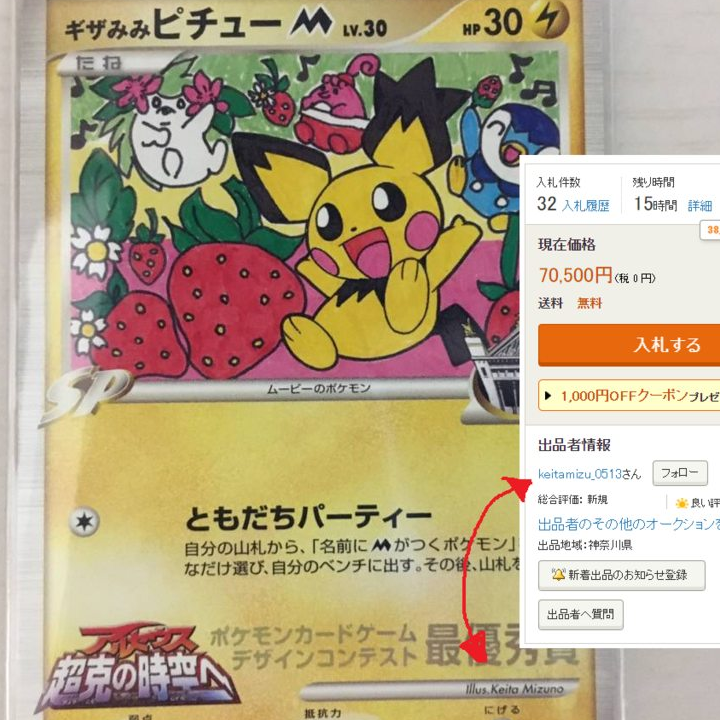
Instagram user Kuma (@pokekuma13) asked a Japanese friend of theirs to reach out to the seller to see if we could get some clarity around how these were distributed (see the Modern Day Confusion section above).
Unfortunately Yahoo! Japan Auctions only allows users to message other users if they have items for sale, and by the time their friend was ready to ask the listing had already sold.
On 12th December 2020 the seller listed another copy of the same card for sale - this time without any visible creases - and Kuma was quick to reach out to their Japanese friend a second time. This time their friend’s question went through successfully and as luck would have it the seller replied a couple of hours later:[10]

The questions Kuma’s friend asked were:
- Are you the winner of the contest?
- Did you get a certificate for winning the contest?
- Have you sold these cards outside of Yahoo! Japan Auctions?
The seller answered with:
- I am the original winner.
- I didn’t get a certificate from the contest.
- I have only sold one other copy outside of Yahoo! Japan Auctions.
This in my mind proves that the complete sets in circulation (including my own) were extra copies that were likely pocketed by workers in the printing room when the cards were originally printed - presumably instead of being discarded due to there being too many cards per sheet.
With this revelation, I think it’s also safe to say that the majority of the 2010 Design Contest cards we’ve also seen for sale so far are also extra copies and unlikely those distributed to the winners (in much larger numbers than that of the 2009 contest) - although certainly as per the Art Academy contest some will have been sold on by the winners.
Part 2
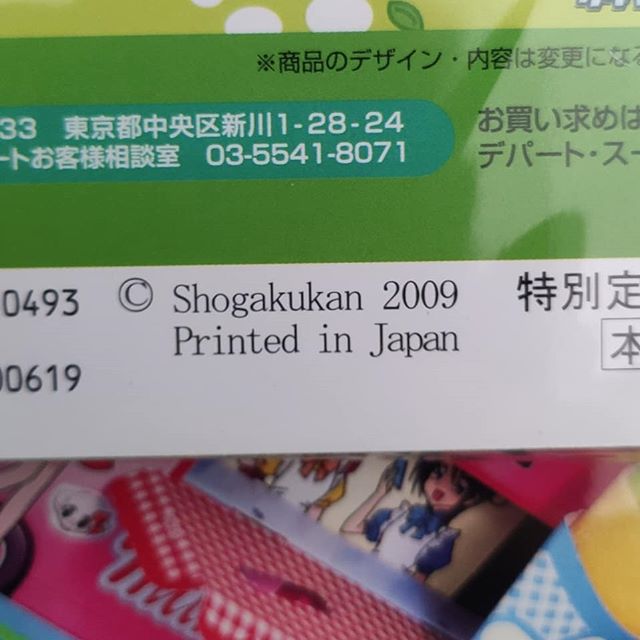
I’ve recently picked up several of Shogakukan’s magazines published around the time of the contest in order to hopefully reveal additional information. Having already received a couple of them, I can confirm that Shogakukan themselves also made the same claims as the Japanese Pokémon website about each winner receiving 100 of their design and each runner-up being awarded a jumbo card with their design on.
I’ll follow up eventually with a part 2 to this blog post which will aim to go into detail about each of the individual contests, the winning cards and the runner-up prizes. Unfortunately this may take a very long time, but I’m adamant that I want to get to the bottom of this, even if that means trying to reach out to some of the winners and runner-ups, which I imagine will be very difficult.
Watch this space…
References
- web.archive.org. 2009. 「小学館児童誌12誌連合 ポケモンカードゲーム デザインコンテスト」が開催されるよ! | カードゲーム関連 | ニュース | ポケットモンスターオフィシャルサイト [online] Available at: http://web.archive.org/web/20090302062932/http://www.pokemon.co.jp/info/card/cg090227_01.html [Accessed 20th June 2020]
- web.archive.org. 2010. 限定カードプレゼント!! 「小学館 ポケモンカードゲーム デザインコンテスト」応募は4月24日まで! [online] Available at: http://web.archive.org/web/20100917111321/http://www.pokemon.co.jp/info/2010/02/cg100226_02.html?i001=news [Accessed 20th June 2020]
- psacard.com. 2020. 2010 Pokemon Japanese Design Contest Promo [online] Available at: https://www.psacard.com/pop/tcg-cards/2010/pokemon-japanese-design-contest-promo/101528 [Accessed 20th June 2020]
- psacard.com. 2020. 2009 Pokemon Japanese Design Contest Promo [online] Available at: https://www.psacard.com/pop/tcg-cards/2009/pokemon-japanese-design-contest-promo/109046 [Accessed 20th June 2020]
- psacard.com. 2020. 2015 Pokemon Japanese XY Promo [online] Available at: https://www.psacard.com/pop/tcg-cards/2015/pokemon-japanese-xy-promo/128401 [Accessed 20th June 2020]
- psacard.com. 2020. 2015 Pokemon Art Academy Competition [online] Available at: https://www.psacard.com/pop/tcg-cards/2015/pokemon-art-academy-competition/132650 [Accessed 20th June 2020]
- bulbapedia.bulbagarden.net. 25th May 2013. Difference between revisions of “Illustration contests” [online] Available at: https://bulbapedia.bulbagarden.net/w/index.php?title=Illustration_contests&diff=1908762&oldid=1892042 [Accessed 20th June 2020]
- youtube.com. 19th November 2010. Pokemon Illustrator Design Contest Arceus & Pichu Cards! [online] Available at: https://www.youtube.com/watch?v=4hEBjW9QLEo [Accessed 21st June 2020]
- youtube.com. 11th May 2011. Review: Pokemon 2009 Pichu Arceus Illustrator Trophy Promo No.3 [online] Available at: https://www.youtube.com/watch?v=dmfrA9MGvnk [Accessed 21st June 2020]
- web.archive.org. 16th December 2020. 出品者への質問:【世界で100枚】ポケモンカード プロモ デザインコンテスト最優秀賞ギザみみピチューM 美品 [online] Available at: https://web.archive.org/web/20201216112432/https://auctions.yahoo.co.jp/jp/show/qanda?aID=n480246792 [Accessed 16th December 2020]
- auctions.yahoo.co.jp. 15th July 2021. ポケモンカード 幻影のゾロア プロモ [online] Available at: https://page.auctions.yahoo.co.jp/jp/auction/d538619734 [Accessed 15th July 2021]
- efour.proboards.com. 15th July 2021. Winners of the 2010 Design Contest received 200 cards [online] Available at: https://efour.proboards.com/thread/24778/winners-design-contest-received-cards [Accessed 15th July 2021]